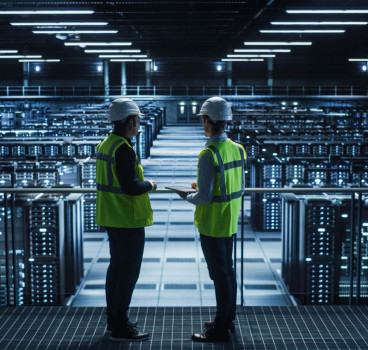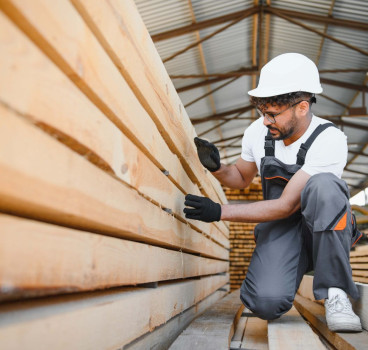A boost for clean construction and sustainability in the U.S.
With growing awareness about climate change and the need to shift toward more sustainable practices, the U.S. government has taken bold steps to spearhead environmentally friendly construction efforts. Among these is the Federal Buy Clean Initiative, launched three years ago and recently updated by the White House. It is an initiative, which is part of a broader strategy to decarbonise federal procurement practices and promote sustainable building materials and methods across the United States – and it appears to be working, writes John Ridgeway.
The Federal Buy Clean Initiative was initially launched in 2021 with the objective of reducing greenhouse gas emissions across federally funded construction projects. The initiative was aimed to prioritise the procurement of materials, especially carbon-intensive ones like steel, concrete and asphalt, that have lower embodied carbon. Such "embodied carbon" applies to the total emissions generated from the production, transportation, installation, maintenance and disposal of building materials.
Through this initiative, the U.S. federal government, which is one of the largest buyers of construction materials in the world, is using its purchasing power to create demand for low-carbon materials and in turn, it is hoped that this will drive significant reductions in greenhouse gas emissions from the construction sector.
In September 2023, the White House released an update on the progress of the Buy Clean Initiative, announcing a major expansion in both public and private sector participation. This was a significant update as it highlighted several companies and state entities that have committed to the goals of the initiative, including major corporations and key states.
Among the new participants are influential organisations such as Cemex, Turner Construction Company, Amazon Web Services and Microsoft, which have all pledged to prioritise the use of sustainable building materials and practices. This helps to ensure private sector alignment with federal sustainability goals and also represents a major shift in corporate social responsibility, particularly within the construction and technology sectors.
In addition to these corporate commitments, several state and local governments have also joined the initiative under the Federal-State Buy Clean Partnership, including the states of New York, Michigan, Washington and Los Angeles. These states and local authorities are taking steps to incorporate sustainability guidelines into their procurement policies, further extending the impact of the initiative across the country.
New York City has gone a little further and is expected to roll out new requirements for environmental product declarations (EPDs) for construction materials like concrete and steel. EPDs serve as a standardised method for reporting the environmental impacts of materials, and their adoption signals a clear move toward more transparent and accountable material sourcing.
To date, the initiative has received substantial federal funding, with $4.5 billion already allocated through the Inflation Reduction Act (IRA) to help boost clean construction efforts. This level of investment underscores the government’s commitment to transitioning the U.S. construction industry to a low-carbon, sustainable future.
The role of concrete and steel
The construction industry particularly relies heavily on concrete and steel - two of the most carbon-intensive building materials. Globally, these materials account for a large share of industrial emissions, with concrete alone responsible for around 8% of the world’s CO2 emissions. Steel production, meanwhile, is one of the highest emitters within the industrial sector.
The Buy Clean Initiative aims to decarbonise these materials by encouraging the use of low-carbon alternatives. This includes promoting technologies like carbon capture and storage (CCS) in cement production and incentivising the use of recycled steel, which has a significantly lower carbon footprint compared to virgin steel.
To support this transition, the initiative calls for the inclusion of environmental product declarations (EPDs) in procurement processes. EPDs offer detailed reports on the lifecycle environmental impact of materials, providing critical data on carbon emissions, energy usage, and resource efficiency. By making EPDs a key requirement, the initiative aims to drive transparency and encourage companies to adopt greener manufacturing practices.
The success of the Buy Clean Initiative hinges on the collaboration between public and private sectors. The initiative’s recent update has seen a marked increase in corporate participation, signalling growing recognition from businesses of the importance of sustainable construction.
A good example is Cemex, one of the world’s largest concrete manufacturers, which is playing a pivotal role by advancing its commitment to low-carbon concrete. The company has set ambitious climate targets, including reducing its CO2 emissions by 40% by 2030, which aligns with the federal government's objectives of reducing the carbon intensity of building materials.
Similarly, Turner Construction Company - one of the largest construction firms in the U.S. - is embracing the transition to clean construction by introducing innovative techniques that minimise carbon emissions across its projects. Turner's participation in the initiative demonstrates how builders are recognising the need to integrate sustainability into all phases of construction, from material sourcing to project execution.
On the technology side, Amazon Web Services (AWS) and Microsoft have committed to adopting green building practices for their data centres and offices, setting a strong example of how digital infrastructure can be built sustainably. These companies are leaders in the development of sustainable cloud computing infrastructure, which relies on energy-efficient building designs and clean energy sources. Their involvement in the Buy Clean Initiative showcases the potential for technology and construction to converge in support of broader climate goals.
Material prices and availability
The Buy Clean Initiative is expected to have a profound impact on the availability and pricing of construction materials, particularly low-carbon alternatives. As demand for low-carbon concrete and sustainable steel grows, the supply chains for these materials will need to evolve. While the upfront cost of low-carbon materials may be higher, the initiative's emphasis on sustainable procurement will drive innovation in material production, leading to increased availability and eventually more competitive pricing. Companies that are prepared to invest in greener production technologies, such as carbon capture and recycling, are likely to benefit from government incentives and market demand, resulting in a more robust supply of sustainable building materials.
In the short term, adopting sustainable materials may lead to higher initial costs for construction projects. However, as more companies enter the market and competition increases, prices are expected to stabilise. Additionally, the long-term benefits of using low-carbon materials - such as reduced operational costs, increased energy efficiency and improved building resilience - will likely outweigh the initial price premiums.
Government incentives, such as grants and tax breaks provided under the Inflation Reduction Act, are also designed to offset these upfront costs. By making it financially feasible for developers to choose sustainable materials, the government aims to accelerate the adoption of green building practices nationwide.
But what does all this mean for the rest of the world? The Buy Clean Initiative is likely to have a ripple effect beyond U.S. borders. As the federal government increasingly prioritises low-carbon materials, global suppliers will need to adapt to meet the growing demand for sustainable products. Countries with robust manufacturing capabilities, especially in steel and concrete, may find themselves at an advantage if they can produce and export low-carbon alternatives.
Conversely, manufacturers that fail to invest in greener technologies risk falling behind, especially as other nations implement their own versions of "Buy Clean" policies. In this way, the U.S. initiative may spur a broader global transition to sustainable construction materials.
There is no doubt that the Federal Buy Clean Initiative represents a crucial step toward decarbonising the construction sector, one of the largest contributors to global greenhouse gas emissions. With significant federal funding and widespread support from both public and private sectors, the initiative is poised to drive meaningful change in how building materials are sourced, produced and used across the U.S.
Additional Blogs

What if Building Control went fully digital?
Building control governs structural integrity, fire protection, energy efficiency, accessibility and countless other aspects of design and construction. Historically, this process has been highly...
Read moreWhere most “Smart Buildings” go wrong
Smart buildings are often presented as the ultimate in modern construction - interconnected, efficient, intuitive and driven by real-time data. They promise lower operating costs, reduced energy use,...
Read more

The future of facilities management starts at RIBA Stage 0
Facilities management has traditionally been treated as a discipline that only becomes relevant once a building is handed over. At that point, FM professionals inherit decisions made months or years...
Read more